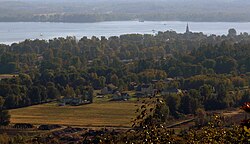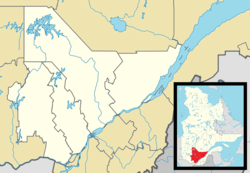Oka, Quebec
| Oka | |
|---|---|
| Municipality | |

Oka village and Lake of Two Mountains as seen from Mount Oka
|
|
 Location within Deux-Montagnes RCM. |
|
| Location in central Quebec. | |
| Coordinates: 45°28′N 74°05′W / 45.467°N 74.083°WCoordinates: 45°28′N 74°05′W / 45.467°N 74.083°W | |
| Country |
|
| Province |
|
| Region | Laurentides |
| RCM | Deux-Montagnes |
| Settled | 1721 |
| Constituted | September 8, 1999 |
| Government | |
| • Mayor | Richard Lalonde |
| • Federal riding | Mirabel |
| • Prov. riding | Mirabel |
| Area | |
| • Total | 85.90 km2 (33.17 sq mi) |
| • Land | 57.30 km2 (22.12 sq mi) |
| Population (2011) | |
| • Total | 3,969 |
| • Density | 69.3/km2 (179/sq mi) |
| • Pop 2006-2011 |
|
| • Dwellings | 1,633 |
| Time zone | EST (UTC−5) |
| • Summer (DST) | EDT (UTC−4) |
| Postal code(s) | J0N 1E0 |
| Area code(s) | 450 and 579 |
| Highways |
|
| Website | www |
Oka is a small Canadian village on the northern bank of the Ottawa River (Rivière des Outaouais in French), northwest of Montreal, Quebec. Located in the Lower Laurentians on Lake of Two Mountains, where the Ottawa has its confluence with the St. Lawrence River, the town has a main thoroughfare that is now part of Quebec Route 344.
This area was first settled by French colonists as a mission to First Nations in 1721 by brothers of the Sulpician Order branch of the Roman Catholic Church. Early native inhabitants were Mohawk (Kanienkaha), Algonquin, and Nipissing, who had a village known as Kanesatake, now a reserve within the boundaries of Oka.
Oka is historically connected to the first Amerindian mission established by the Sulpicians in Montreal. It was in 1718, moreover, that the Sulpicians obtained from the King of France the concession of the seigneury of Deux-Montagnes which corresponded to the present territories of the parishes of Oka, Saint-Placide, Saint-Benoît, Saint-Joseph The lake and the surrounding area.
The mission of La Montagne was transferred in 1696 to Sault-au-Récollet in Montreal and from there to Lac des Deux-Montagnes in 1721. This last movement was facilitated by the fact that in 1717 the Seigneurie du Lac Of the Deux-Montagnes was conceded to the Sulpicians by the King of France on the express condition of transferring the Indian mission there. Final concession was given in 1718 after the transfer of the mission proper. In 1720 Catholic Iroquois who were previously at the Sault au Récollet mission were moved to the new location. In 1721, under the direction of Quere de Tréguron, Sulpician, a group of Algonquins and Iroquois emigrated on the shores of Lake Deux-Montagnes.
By 1722 the transfer was almost completed. The proposed site was advantageous for the conversion of the Indians and for their defense and that of the colony. To prepare their installation, another Sulpician, Mr. Gay (who was the superior), made some clearing and build various buildings including a chapel, the missionary's house, a school intended for the Sisters of the Congregation Notre-Dame as well as cabins for the Indians. The Indian population increased considerably around 1727 when the Nipissingues and the Algonquins of the Île-aux-Tourtes mission also came to the Lake with their missionary Pierre-Élie Déperet.
...
Wikipedia

